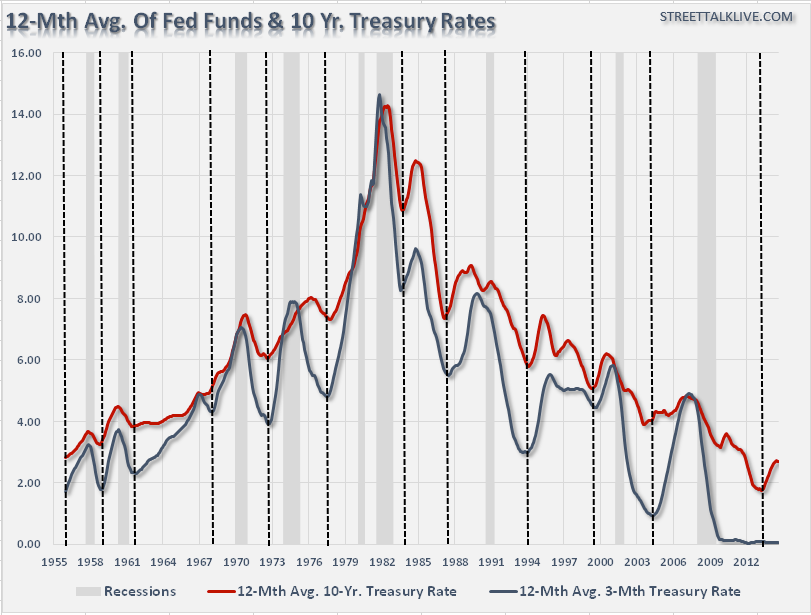Lately I've seen numerous articles and comments made that just because the Federal Reserve raises interest rates it will only affect the short end of the yield curve -- but not the long end. That premise is used to support the bullish thesis that the Fed can raise the overnight lending rate, but leave longer-term interest rates low thereby supporting economic growth and elevated stock prices. Is that premise accurate?
To answer that question, we must look at the history of the two interest rates in question. I have used a 3-month treasury rate which replicates the Fed Funds rate. In order to more clearly see the trend and turning points of the two rates, I have smoothed both using a 12-month average.

The dotted black lines denotes when the 3-month treasury began to increase. Note that in every instance the 10-Year rate began to increase as well.
Of course, this is perfectly logical. Banks borrow money from the Federal Reserve at the lower rate and then lend out at a higher rate, which is typically benchmarked to the 10-year treasury. When the banks borrowing costs increase the rate at which they lend out also increases as higher costs are passed through to borrowers.
Rising rates are historically associated with stronger levels of economic growth as borrowers can justify higher interest rate costs as the spread between the loan and capital project are profitable. However, as rates continue to rise, net profitability is reduced which ultimately acts as a "brake" on economic activity.
As shown in the table below, increases in interest rates eventually have a deleterious outcome to either the economy, financial markets or both.

The table above shows the start/end of the interest rate increase cycles for both rates. In all cases, as the short-term interest rate rose the longer end of the yield curve also increased. The impact of higher borrowing costs, as stated above, has always led to negative outcomes. As I addressed in
This is something that I addressed more deeply in "Don't Fear Rising Interest Rates? Really?"
"Do Rising Interest Rates Lead To Higher Stock Prices? This claim falls into the category of "timing is everything." The chart below has been circulated quite a bit to support the "don't fear rising interest rates" meme. I have annotated the chart to point out the missing pieces.

As I stated above, timing is everything. While rising interest rates may not "initially" drag on asset prices, it is a far different story to suggest that they won't. I addressed this issue previously in "Why Market Bulls Should Hope Interest Rates Don't Rise." In that missive I pointed out twelve (12) reasons why rising interest rates are a problem, particularly when those rate increases are coming from a period of very low economic growth."

What is important is the DECLINE in the yield spread. When the yield spread declines, it is indicative of tighter economic conditions. It is important to note that historically the yield spread has declined rapidly, which is why investors need to be conscious of how quickly this dynamic can change.
For investors, there are several things to take away from this analysis
1) There have been ZERO times that the Federal Reserve has entered into a rate hiking campaign that did not have a negative consequence.
2) The average period following an increase in the effective funds rate to either a stock market correction, economic recession or both has been 20.75 months. Therefore, if we assume an initial increase in the Fed funds rate in June of 2015, that would put the next negative event sometime in the first quarter of 2017.3) However, the median number of months following the initial rate hike has been 17 months. This would advance the timeframe into mid-2016. Such a timeframe would coincide with both the Decennial and Presidential cycles as discussed previously.
4) Importantly, there have been only two times in recent history that the Federal Reserve has increased interest rates from such a low level of annualized economic growth. The most relevant period was in 1983 when the economy was recovering from two adjacent recessions. Due to such weak economic growth, the impact of rising interest rates tripped up the stock market just 17 months later.
5) Lastly, it is crucially important to recognize that the ENTIRETY of the "bullish" analysis is based on a sustained 34-year period of falling interest rates, inflation and annualized rates of economic growth. With all of these variables near historic lows there is no way to assume how asset prices, or economic growth, will fair going forward.
What is clear from the analysis is that the net, full-cycle, return to investors has been dismal following the Federal Reserve's first interest rate increase. While it may initially seem that stocks can weather higher interest rates, it is only because it requires 6-9 months before a rate hike impacts the economy. Much like a car hitting its brakes in traffic, as one rate hike compounds on the next, the eventual outcome is a complete traffic jam.
For now the bullish trend is still in place that needs to be "consciously" honored. However, while it may seem that nothing can stop the market's current rise, it is crucial to remember that it is "only like this, until it is like that." For those "asleep at the wheel," there will be a heavy price to pay when the taillights turn red.
